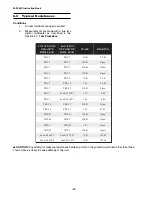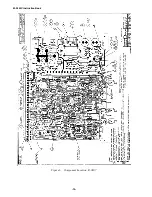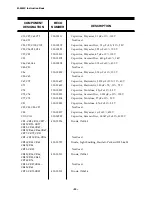
–5–
■
NOTE: To prevent the voltage level detection
circuit outputs from oscillating, there is
approximately 0.5 V rms hysteresis
between when the LEDs turn on and turn
off, within a dial setting accuracy of
K
2%
of full scale.
4.
The LOWER VOLTAGE-LINE LED should
light.
5.
Slowly reduce the Line voltage; the LOWER
VOLTAGE LIMIT-LINE LED should go out
as the Line voltage input drops below 105
V rms.
6.
Slowly increase the Line voltage input; the
LOWER VOLTAGE LIMIT-LINE LED
should light as the voltage level passes
105 V rms.
7.
Return the Line voltage input to 120 V rms.
8.
Repeat steps 3 through 6 with the LOWER
VOLTAGE LIMIT set at 95 V rms, then at
115 V rms.
Phase Angle Limit
■
NOTE: The following section is written for a 60°
full scale unit. Multiply accordingly for other
scale options.
1.
Adjust the Line voltage input to 120 V rms,
60 [50] Hz.
2.
Adjust the Motor Bus voltage input to 120 V
rms, 60 [50] Hz.
3.
The phase angle meter reading and
synchroscope should show a stable phase
angle.
4.
Set the PHASE ANGLE LIMIT dial at
midscale (30°).
5.
Adjust the phase angle between the Line
and Motor Bus voltage inputs to 29.5°.
■
NOTE: To prevent the voltage level detection
circuit outputs from oscillating, there is
approximately 0.5 V rms hysteresis
between when the LEDs turn on and turn
off, within a dial setting accuracy of
K
2%
of full scale.
6.
The PHASE ANGLE OK LED should light.
7.
Slowly increase the phase angle between
the sources; the PHASE ANGLE OK LED
should go out as the phase angle passes
30°.
8.
Slowly reduce the phase angle; the
PHASE ANGLE OK LED should come on
as the phase angle drops below 30°.
9.
Repeat steps 4 through 8 with the PHASE
ANGLE LIMIT dial set at 10° and 50°.
10.
Return both inputs to 120 V rms, 60
[50] Hz.
Voltage Analog Output
1.
Connect the positive lead of the multimeter
to TB1-28.
2.
Connect the negative (common) lead of
the multimeter to TB1-7.
3.
The dc voltage reading should be
proportional to the Line voltage input ac
level, which should be 0 to 7 V dc as the
Line voltage input varies from 0 to 140 V
rms. The accuracy should be
K
2% of full
scale.
4.
Move the DMM positive lead from TB1-28
to TB1-18. The negative lead remains on
TB1-7.
5.
The dc voltage reading should be 0 to 7 V
dc as the Motor Bus voltage input varies
from 0 to 140 V rms. The accuracy should
be ±2% of full scale.
Phase Angle Analog Output
1.
Connect the DMM positive lead to TB1-5.
2.
Connect the DMM negative lead to TB1-7.
3.
The dc voltage reading should be 0 to 10
V dc as the phase angle between the Line
input and the Motor Bus input changes
from 0° to 180°. The accuracy should be
±1% of full scale.
Voltage Status Output Contact
1.
Place one ohmmeter across TB1-22 and
TB1-23.
2.
Set the UPPER VOLTAGE LIMIT dial at
125 V rms.
3.
Set the LOWER VOLTAGE LIMIT dial at
105 V rms.
4.
Adjust the Motor Bus voltage input level to
120 V rms, 60 [50] Hz.
5.
Adjust the Line voltage input level to 120 V
rms, 60 [50] Hz.
6.
The VOLTAGE LIMIT LED should be lit.
7.
The Voltage Status Contact from TB1-22
to TB1-23 should be closed.
8.
Set the UPPER VOLTAGE LIMIT dial to
115 V rms.
9.
The Voltage Status Contact from TB1-22
to TB1-23 should open when the UPPER
VOLTAGE LIMIT-LINE LED is off.
Summary of Contents for M-0245C
Page 1: ...Instruction Book M 0245C High Speed Sync Check Relay ...
Page 23: ... 14 M 0245C Instruction Book Figure 6 Component Location B 0207 ...
Page 24: ... 15 Figure 7 Variable Speed Motor Application Component Location B 0264 ...
Page 25: ... 16 M 0245C Instruction Book ...
Page 26: ... 17 Figure 8 Schematic X 0245C ...















































